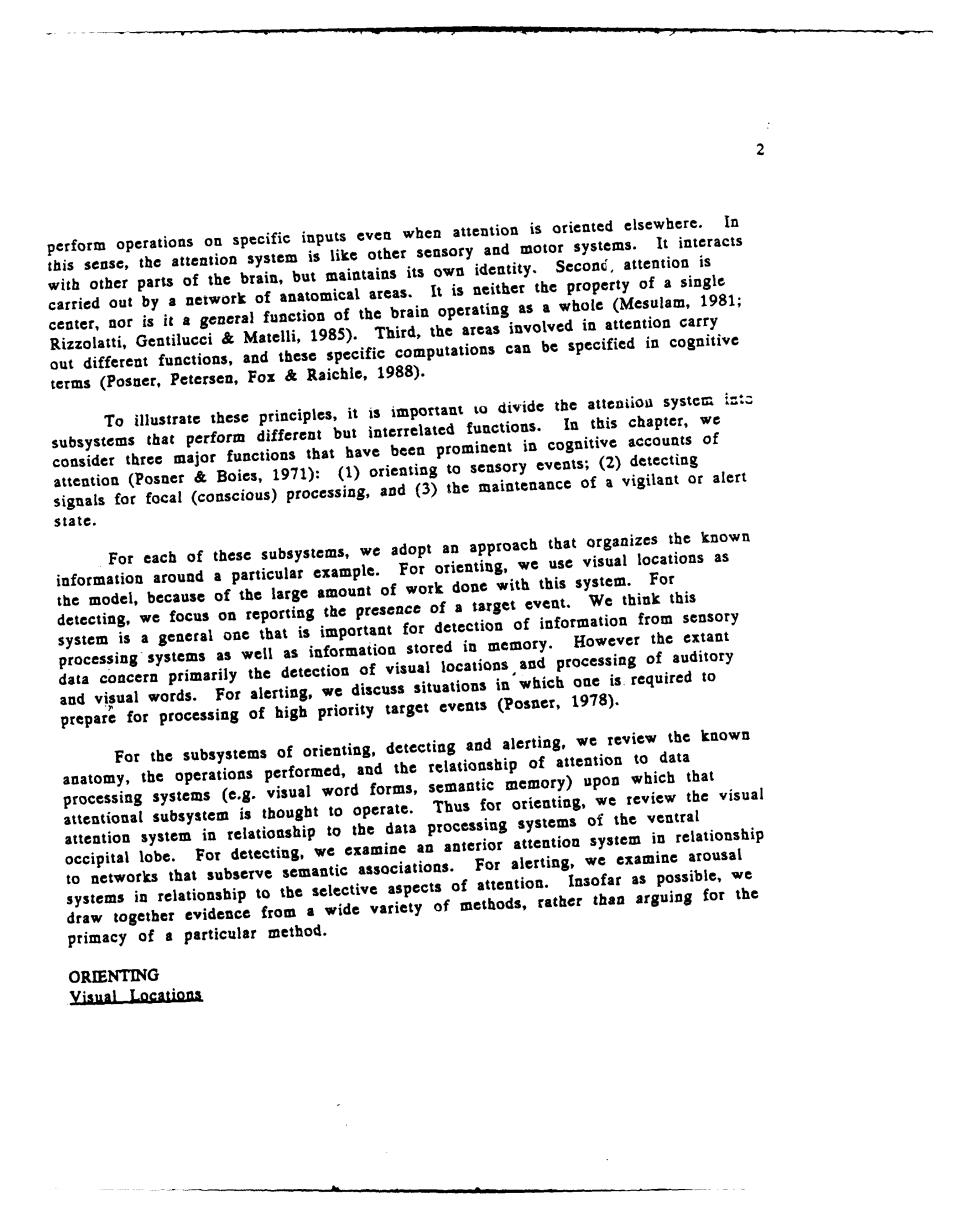正在加载图片...

a when attention is oriented elsewhere. interacts with other parts of the brain maintains its own identity. of a single carried out by a network of the brain operatinged in attention carry ceater,orsMatei.9).Third,the Rizzolatti,Ge and these specific computations can be specified in cognitive n For Raichle,1988) tem ists To illustrate these principles,it is imp elated functions. syst we have been prominent in cogni attention (Posner B (1)orienting to seasory :(2)detecting signals for focal(conscio essing and (3)the mainte eveofa vigilant or alert state. For each of these subsystems,we adopt an und a particular example. of the arge of k done with this system nk this we focus on reporti ag tae p for detection of information om sensory tion stored in memory. er the extant data concern pri of visual locations,an and visual words we discuss situations in required to prepare for processing of bigh priority target events (Po 19781 For the subsystems of orienting,detecting and alerting,we review the kaown erations performed,and the aship of aitention to ems (e.g.visual word for memory)upon subsystem is thought to opera Thus for orienting, the visual system in relationship to the cessing systems of an anterior attention syste in relationship cipital lobe.For detecting, to networks that subserve se associations.For alerting, amine arousal ive aspects of attention. as possible,we a wide variety of methods,rather than arguing for the draw together evid primacy of a particular method.2 perform operations on specific inputs even when attention is oriented elsewhere. In this sense, the attention system is like other sensory and motor systems. It interacts with other parts of the brain, but maintains its own identity. SeconC, attention is carried out by a network of anatomical areas. It is neither the property of a single center, nor is it a general function of the brain operating as a whole (Mesulam, 1981; Rizzolatti, Gentilucci & Matelli, 1985). Third, the areas involved in attention carry out different functions, and these specific computations can be specified in cognitive terms (Posner, Petersen, Fox & Raichle, 1988). To illustrate these principles, it is important to divide the attenDti systC i-z subsystems that perform different but interrelated functions. In this chapter, we consider three major functions that have been prominent in cognitive accounts of attention (Posner & Boies, 1971): (1) orienting to sensory events; (2) detecting signals for focal (conscious) processing, and (3) the maintenance of a vigilant or alert state. For each of these subsystems, we adopt an approach that organizes the known information around a particular example. For orienting, we use visual locations as the model, because of the large amount of work done with this system. For detecting, we focus on reporting the presence of a target event. We think this system is a general one that is important for detection of information from sensory processing systems as well as information stored in memory. However the extant data concern primarily the detection of visual locations and processing of auditory and visual words. For alerting, we discuss situations in which one is required to prepare for processing of high priority target events (Posner, 1978). For the subsystems of orienting, detecting and alerting, we review the known anatomy, the operations performed, and the relationship of attention to data processing systems (e.g. visual word forms, semantic memory) upon which that attentional subsystem is thought to operate. Thus for orienting, we review the visual attention system in relationship to the data processing systems of the ventral occipital lobe. For detecting, we examine an anterior attention system in relationship to networks that subserve semantic associations. For alerting, we examine arousal systems in relationship to the selective aspects of attention. Insofar as possible, we draw together evidence from a wide variety of methods, rather than arguing for the primacy of a particular method. ORIENTING Visual Loations